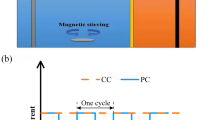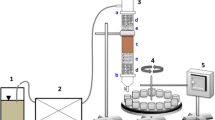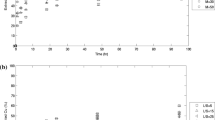Abstract
A comparison of Cu extraction yields for three different ethylenediamine-N,N′-disuccinic acid (EDDS)-enhanced washing configurations was performed on a Cu-contaminated soil. Batch experiments were used to simulate a single-stage continuous stirred tank reactor (CSTR) and a multi-stage (side feeding and counter-current) reactor. Single-stage CSTR conditions were simulated for various EDDS:(Cu + Cd + Pb + Co + Ni + Zn) molar ratio (EDDS:M ratio) (from 1 to 30) and liquid to soil (L/S) ratio (from 15 to 45). The highest Cu extraction yield (≃56%) was achieved with EDDS:M = 30. In contrast, a Cu extraction yield decrease was observed with increasing L/S ratio with highest extracted Cu achievement (≃48%) for L/S = 15. Side feeding configuration was tested in four experimental conditions through different fractionation mode of EDDS dose and treatment time at each washing step. Results from the four tests showed all enhanced Cu extraction (maximum values from ≃43 to ≃51%) achieved at lower treatment time and lower EDDS:M molar ratio compared to CSTR configuration with L/S = 25 and EDDS:M = 10. The counter-current washing was carried out through two washing flows achieving a process performance enhancement with 27% increase of extracted Cu compared to single-stage CSTR configuration. Higher Cu extraction percentage (36.8%) was observed in the first washing phase than in the second one (24.7%).





Similar content being viewed by others
References
Abumaizar RJ, Smith EH (1999) Heavy metal contaminants removal by soil washing. J Hazard Mater 70:71–86. doi:10.1016/S0304-3894(99)00149-1
Ager P, Marshall WD (2003) Recycle of thermomechanical pulp filtrate after the removal of metals: a study with EDTA. J Pulp Pap Sci 29:303–307
Allen HE, Chen P-H (1993) Remediation of metal contaminated soil by EDTA incorporating electrochemical recovery of metal and EDTA. Environ Prog 12:284–293. doi:10.1002/ep.670120409
ASTM D 2974-00 (2000) Standard test methods for moisture, ash and organic matter of peat and other organic soils. ASTM International, West Conshohocken
ASTM D 422-63 (2007) Test method for particle-size analysis of soils. ASTM International, West Conshohocken
Barona A, Aranguiz I, Elías A (2001) Metal associations in soils before and after EDTA extractive decontamination: implications for the effectiveness of further clean-up procedures. Environ Pollut 113:79–85. doi:10.1016/S0269-7491(00)00158-5
Begum ZA, Rahman IMM, Tate Y et al (2012) Remediation of toxic metal contaminated soil by washing with biodegradable aminopolycarboxylate chelants. Chemosphere 87:1161–1170. doi:10.1016/j.chemosphere.2012.02.032
Dermont G, Bergeron M, Mercier G, Richer-Laflèche M (2008) Soil washing for metal removal: a review of physical/chemical technologies and field applications. J Hazard Mater 152:1–31. doi:10.1016/j.jhazmat.2007.10.043
Di Palma L, Ferrantelli P, Merli C, Biancifiori F (2003) Recovery of EDTA and metal precipitation from soil flushing solutions. J Hazard Mater 103:153–168. doi:10.1016/S0304-3894(03)00268-1
Di Palma L, Ferrantelli P, Medici F (2005) Heavy metals extraction from contaminated soil: recovery of the flushing solution. J Environ Manag 77:205–211. doi:10.1016/j.jenvman.2005.02.018
Elliott HA, Linn JH, Shields GA (1989) Role of Fe in extractive decontamination of Pb-polluted soils. Hazard Waste Hazard Mater 6:223–229. doi:10.1089/hwm.1989.6.223
Espino-Mesa M, Arbelo CD, Hernandez-Moreno JM (1993) Predicting value of diagnostic soil properties on actual and potential cation exchange capacity (CEC) in Andisols and andic soils. Commun Soil Sci Plant Anal 24:2569–2584
Fabbricino M, Ferraro A, Del Giudice G, d’Antonio L (2013) Current views on EDDS use for ex situ washing of potentially toxic metal contaminated soils. Rev Environ Sci Bio/Technol 12:391–398. doi:10.1007/s11157-013-9309-z
Ferraro A, van Hullebusch ED, Huguenot D et al (2015) Application of an electrochemical treatment for EDDS soil washing solution regeneration and reuse in a multi-step soil washing process: case of a Cu contaminated soil. J Environ Manag 163:62–69. doi:10.1016/j.jenvman.2015.08.004
Ferraro A, Fabbricino M, van Hullebusch ED et al (2016a) Effect of soil/contamination characteristics and process operational conditions on aminopolycarboxylates enhanced soil washing for heavy metals removal: a review. Rev Environ Sci Bio/Technol 15:111–145. doi:10.1007/s11157-015-9378-2
Ferraro A, Fabbricino M, van Hullebusch ED, Esposito G (2016b) Calibration and validation of a two-step kinetic mathematical model for predicting Cu extraction efficiency in an EDDS-enhanced soil washing. Water Air Soil Pollut 227:1–11. doi:10.1007/s11270-016-2764-8
Finzgar N, Lestan D (2007) Multi-step leaching of Pb and Zn contaminated soils with EDTA. Chemosphere 66:824–832. doi:10.1016/j.chemosphere.2006.06.029
Fischer K, Bipp H-P, Riemschneider P et al (1998) Utilization of biomass residues for the remediation of metal-polluted soils. Environ Sci Technol 32:2154–2161. doi:10.1021/es9706209
Guo H, Wang W, Sun Y et al (2010) Ethyl lactate enhances ethylenediaminedisuccinic acid solution removal of copper from contaminated soils. J Hazard Mater 174:59–63. doi:10.1016/j.jhazmat.2009.09.016
Hauser L, Tandy S, Schulin R, Nowack B (2005) Column extraction of heavy metals from soils using the biodegradable chelating agent EDDS. Environ Sci Technol 39:6819–6824. doi:10.1021/es050143r
Hong PKA, Cai X, Cha Z (2008) Pressure-assisted chelation extraction of lead from contaminated soil. Environ Pollut 153:14–21. doi:10.1016/j.envpol.2007.12.022
Kim C, Lee Y, Ong SK (2003) Factors affecting EDTA extraction of lead from lead-contaminated soils. Chemosphere 51:845–853. doi:10.1016/S0045-6535(03)00155-3
Komárek M, Száková J, Rohošková M et al (2008) Copper contamination of vineyard soils from small wine producers: a case study from the Czech Republic. Geoderma 147:16–22. doi:10.1016/j.geoderma.2008.07.001
Koopmans GF, Schenkeveld WDC, Song J et al (2008) Influence of EDDS on metal speciation in soil extracts: measurement and mechanistic multicomponent modeling. Environ Sci Technol 42:1123–1130. doi:10.1021/es071694f
Lestan D, Luo C, Li X (2008) The use of chelating agents in the remediation of metal-contaminated soils: a review. Environ Pollut 153:3–13. doi:10.1016/j.envpol.2007.11.015
Levenspiel O (1972) Chemical reaction engineering. J Wiley and Sons, New York
Lim T-T, Chui P-C, Goh K-H (2005) Process evaluation for optimization of EDTA use and recovery for heavy metal removal from a contaminated soil. Chemosphere 58:1031–1040. doi:10.1016/j.chemosphere.2004.09.046
Mohanty B, Mahindrakar AB (2011) Removal of heavy metal by screening followed by soil washing from contaminated soil. Int J Technol Eng Syst 2:290–293
Papassiopi N, Tambouris S, Kontopoulos A (1999) Removal of heavy metals from calcareous contaminated soils by EDTA leaching. Water Air Soil Pollut 109:1–15. doi:10.1023/A:1005089515217
Peters RW (1999) Chelant extraction of heavy metals from contaminated soils. J Hazard Mater 66:151–210. doi:10.1016/S0304-3894(99)00010-2
Pociecha M, Lestan D (2010) Electrochemical EDTA recycling with sacrificial Al anode for remediation of Pb contaminated soil. Environ Pollut 158:2710–2715. doi:10.1016/j.envpol.2010.04.014
Pueyo M, Mateu J, Rigol A et al (2008) Use of the modified BCR three-step sequential extraction procedure for the study of trace element dynamics in contaminated soils. Environ Pollut 152:330–341. doi:10.1016/j.envpol.2007.06.020
Race M, Marotta R, Fabbricino M et al (2016) Copper and zinc removal from contaminated soils through soil washing process using ethylenediaminedisuccinic acid as a chelating agent: a modeling investigation. J Environ Chem Eng 4:2878–2891. doi:10.1016/j.jece.2016.05.031
Sarkar D, Andra SS, Saminathan SKM, Datta R (2008) Chelant-aided enhancement of lead mobilization in residential soils. Environ Pollut 156:1139–1148. doi:10.1016/j.envpol.2008.04.004
Satyro S, Race M, Marotta R et al (2016) Photocatalytic processes assisted by artificial solar light for soil washing effluent treatment. Environ Sci Pollut Res. doi:10.1007/s11356-016-6431-9
Steele MC, Pichtel J (1998) Ex-situ remediation of a metal-contaminated superfund soil using selective extractants. J Environ Eng 124:639–645. doi:10.1061/(ASCE)0733-9372(1998)124:7(639)
Subirés-Muñoz JD, García-Rubio A, Vereda-Alonso C et al (2011) Feasibility study of the use of different extractant agents in the remediation of a mercury contaminated soil from Almaden. Sep Purif Technol 79:151–156. doi:10.1016/j.seppur.2011.01.032
Sun B, Zhao FJ, Lombi E, McGrath SP (2001) Leaching of heavy metals from contaminated soils using EDTA. Environ Pollut 113:111–120. doi:10.1016/S0269-7491(00)00176-7
Tandy S, Bossart K, Mueller R et al (2004) Extraction of heavy metals from soils using biodegradable chelating agents. Environ Sci Technol 38:937–944. doi:10.1021/es0348750
Tandy S, Ammann A, Schulin R, Nowack B (2006) Biodegradation and speciation of residual SS-ethylenediaminedisuccinic acid (EDDS) in soil solution left after soil washing. Environ Pollut 142:191–199. doi:10.1016/j.envpol.2005.10.013
Theodoratos P, Papassiopi N, Georgoudis T, Kontopoulos A (2000) Selective removal of lead from calcareous polluted soils using the Ca-EDTA salt. Water Air Soil Pollut 122:351–368. doi:10.1023/A:1005295119231
Tsang DCW, Lo IMC, Surampalli RY (2012) Design, implementation, and economic/societal considerations of chelant-enhanced soil washing. In: Tsang DCW, Lo IMC, Surampalli RY (eds) Chelating agents for land decontamination technologies. American Society of Civil Engineers, Reston, pp 1–26
USEPA (1995) SW-846 EPA method 3051: microwave assisted acid digestion of sediments, sludges, soils and oils, in: test methods for evaluating solid waste, 3rd Edn, 3rd Update. US Environmental Protection Agency, Washington DC
Van Benschoten JE, Matsumoto MR, Young WH (1997) Evaluation and analysis of soil washing for seven lead-contaminated soils. J Environ Eng 123:217–224. doi:10.1061/(ASCE)0733-9372(1997)123:3(217)
Vandevivere P, Hammes F, Verstraete W et al (2001) Metal decontamination of soil, sediment, and sewage sludge by means of transition metal chelant [S,S]-EDDS. J Environ Eng 127:802–811. doi:10.1061/(ASCE)0733-9372(2001)127:9(802)
Voglar D, Lestan D (2010) Electrochemical separation and reuse of EDTA after extraction of Cu contaminated soil. J Hazard Mater 180:152–157. doi:10.1016/j.jhazmat.2010.04.007
Zeng QR, Sauvé S, Allen HE, Hendershot WH (2005) Recycling EDTA solutions used to remediate metal-polluted soils. Environ Pollut 133:225–231. doi:10.1016/j.envpol.2004.06.006
Zou Z, Qiu R, Zhang W et al (2009) The study of operating variables in soil washing with EDTA. Environ Pollut 157:229–236. doi:10.1016/j.envpol.2008.07.009
Acknowledgments
The authors would like to thank the EU that provided financial support through the Erasmus Mundus Joint Doctorate Programme ETeCoS3 (Environmental Technologies for Contaminated Solids, Soils, and Sediments; grant agreement FPA no. 2010-0009). Moreover, A. Ferraro gratefully thanks the Mediterranean Office for Youth (MOY), which granted a 5-month mobility fellowship in the frame of the MOY-labeled program no. 2010/038, and the Université Franco-Italienne which granted a mobility fellowship in the frame of VINCI 2012 Chapter 4—Collaboration entre Ecoles Doctorales call.
Author information
Authors and Affiliations
Corresponding author
Additional information
Responsible editor: Zhihong Xu
Rights and permissions
About this article
Cite this article
Ferraro, A., Fabbricino, M., van Hullebusch, E.D. et al. Investigation of different ethylenediamine-N,N′-disuccinic acid-enhanced washing configurations for remediation of a Cu-contaminated soil: process kinetics and efficiency comparison between single-stage and multi-stage configurations. Environ Sci Pollut Res 24, 21960–21972 (2017). https://doi.org/10.1007/s11356-017-9844-1
Received:
Accepted:
Published:
Issue Date:
DOI: https://doi.org/10.1007/s11356-017-9844-1




